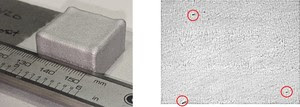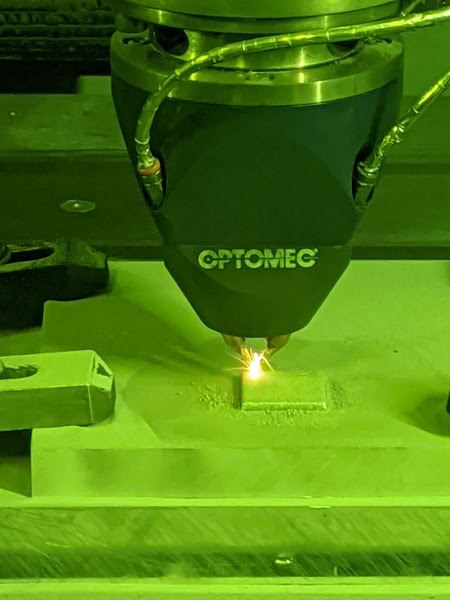According to SmarTech Analysis, aluminum alloys accounted for nearly 10% of 3D printed metal content last year, leading to a 43% growth in shipments of aluminum powder. This is due both to the technological advancements being made in aluminum 3D printing and in the utility of the material, which offers remarkable lightweight characteristics at a fraction of the cost of titanium. As the market it expands, aluminum has grown beyond aerospace applications and is increasingly being adopted by the automotive market.
However, aluminum AM has been the domain of laser powder bed fusion (PBF) technologies, with directed energy deposition (DED) of aluminum typically used for materials research and the exploration of printing large aerospace structural parts. In particular, powder DED, as opposed to wire DED, has played a less significant role in aluminum printing.

An aluminum alloy block deposited with LENS DED (left). Optomec highlights “the very smooth surface finish. Optical micrograph of polished and unetched sample from the same block” (right) and “the low fraction of gas porosity (circles) measured at ~0.1% using image analysis with gray scale thresholding.” Image courtesy of Optomec.
Powder DED leader Optomec is aiming to change that by announcing the use of its LENS DED systems for printing and repairing aluminum parts. This new material now complements Optomec’s existing material portfolio, which includes steels, titanium, nickel and copper.
The company suggests that its LENS process can be used to print or repair parts for the transportation and aerospace sectors, with its simultaneous five-axis system capable of doing so without support structures. To ensure stable deposition of aluminum, printing takes place within an argon gas atmosphere with low oxygen and moisture levels.
David Otazu, LENS Applications Engineer, said, “Our engineers have developed process parameters for aluminum alloys to provide an excellent surface finish, high deposition rates and a density of ~99.9 percent.”
Within aerospace, where DED and aluminum for AM are both most highly represented, DED is most widely being explored for use in producing large near-net shape fuselage components and turbine blades, in which wire-based DED is usually more advantageous, and for repairing or adding features to existing parts, where powder DED is more advantageous.

An Optomec deposition head 3D printing an aluminum block onto a substrate. Image courtesy of Optomec.
As for the automotive space (which SmarTech values at $9B for AM by 2029), aluminum, as well as lightweight steels and composites, is expected to be used increasingly to lower the density of vehicles in order to reduce emissions—though this has been offset by larger and greater numbers of vehicles. Aluminum printing is already used for prototyping in the industry; however, this is mostly via PBF, with metal binder jetting on the horizon. PBF has been used able to produce some impressive end use parts, due to DED’s ability to produce large, near net-shape parts, it has so far been limited to tooling.
While Optomec suggests that its LENS systems can process “any” aluminum alloy, it lists aluminum 4047 alloy on its site specifically. Al4047 is typically a brazing or filler alloy made up of 11 to 13 percent silicon, often used for repairs in aerospace and the automotive industry. So, it wouldn’t be surprising if the company’s customers were looking to use it for these purposes.
If the technology can handle a wide variety of aluminum alloys, there’s the likelihood that applications can expand beyond repair and tooling. This latest material development follows on the qualification of copper for printing with Optomec’s LENS technology, is a part of the company’s gradual growth overall, which includes the acquisition of Huffman (bringing it further into the aerospace and energy markets).
Subscribe to Our Email Newsletter
Stay up-to-date on all the latest news from the 3D printing industry and receive information and offers from third party vendors.
You May Also Like
Precision at the Microscale: UK Researchers Advance Medical Devices with BMF’s 3D Printing Tech
University of Nottingham researchers are using Boston Micro Fabrication‘s (BMF) 3D printing technology to develop medical devices that improve compatibility with human tissue. Funded by a UK grant, this project...
3D Printing Webinar and Event Roundup: April 21, 2024
It’s another busy week of webinars and events, starting with Hannover Messe in Germany and continuing with Metalcasting Congress, Chinaplas, TechBlick’s Innovation Festival, and more. Stratasys continues its advanced training...
3D Printing Webinar and Event Roundup: March 17, 2024
It’s another busy week of webinars and events, including SALMED 2024 and AM Forum in Berlin. Stratasys continues its in-person training and is offering two webinars, ASTM is holding a...
3D Printed Micro Antenna is 15% Smaller and 6X Lighter
Horizon Microtechnologies has achieved success in creating a high-frequency D-Band horn antenna through micro 3D printing. However, this achievement did not rely solely on 3D printing; it involved a combination...





























